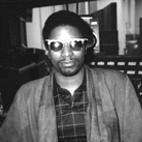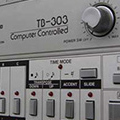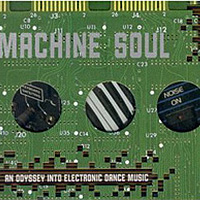By 1985, 3070 was gone, permanently damaged by Vietnam. Atkins hooked up with fellow Belleville High alumni Derrick May and Kevin Saunderson. The three of them began recording together and separately, under various names: Model 500 (Atkins), Reese (Saunderson), Mayday, R-Tyme, and Rhythim is Rhythim (May). All shared an attitude toward making records –using the latest in computer technology without letting machines do everything– and a determination to overcome their environment; like May has said, ” We can do nothing but look forward.”
The trio put out a stream of records in the Detroit area on the Transmat and KMS labels: many of these, like “No UFO’s,” “Strings of Life,” “Rock to the Beat,” and “When He Used To Play,” have the same tempo, about 120 bpm, and feature blank, otherworldly voices –which, paradoxically, communicate intense emotion. These records –now rereleased in Europe on compilations like Retro Techno Detroit Definitive (Network U.K.) or Model 500: Classics (R&S Belgium)– were as good, if not better, as anything coming out of New York or even Chicago, but because of Detroit’s isolation few people in the U.S. heard them at the time. It took English entrepreneurs to give them their correct place in the mainstream of dance culture.
 Like many others, Neil Rushton was galvanized by the electronic music coming out of Chicago mid-decade, which was successfully codified in the English market under the trade name “house.” A similar thing happened in Chicago as in Detroit: away from the musical mainstream on both coasts, DJs like {ln:Frankie Knuckles} and {ln:Marshall Jefferson} had revived a forgotten musical form, disco, and adapted it to the environment of gay clubs like the Warehouse. The result was a spacey, electronic sound, released on local labels like {ln:Trax – The House that built Chicago ‘Trax} and DJ International: funkier and more soulful than techno, but futuristic. As soon as it was marketed in the U.K. as house in early 1987, it because a national obsession with No. 1 hits like “Love Can’t Turn Around” and “Jack Your Body.”
Like many others, Neil Rushton was galvanized by the electronic music coming out of Chicago mid-decade, which was successfully codified in the English market under the trade name “house.” A similar thing happened in Chicago as in Detroit: away from the musical mainstream on both coasts, DJs like {ln:Frankie Knuckles} and {ln:Marshall Jefferson} had revived a forgotten musical form, disco, and adapted it to the environment of gay clubs like the Warehouse. The result was a spacey, electronic sound, released on local labels like {ln:Trax – The House that built Chicago ‘Trax} and DJ International: funkier and more soulful than techno, but futuristic. As soon as it was marketed in the U.K. as house in early 1987, it because a national obsession with No. 1 hits like “Love Can’t Turn Around” and “Jack Your Body.”
House irrevocably turned around English pop music. After the successes of these early records by Steve “Silk” Hurley and Farley “Jackmaster” Funk (with disco diva Darryl Pandy), pop music was dance music, and, more often than not, futuristic black dance music at that. The apparent simplicity of these records coincided with the coming onstream of digital technology whereby, in Atkins’s words, “you have the capability of storing a vast amount of information in a smaller place.” The success of the original house records opened up more trends: {ln:Acid House – The History ‘acid house} –featuring the {ln:Roland TB-303}– was followed by Italian house, and later, Belgian {ln:New Beat: One Nation Under A (Slowed Down) Groove ‘New Beat’s} slower, more industrial dance rhythms.
“The U.K. likes discovering trends,” Rushton says. “Because of the way that the media works, dance culture happens very quickly. It’s not hard to hype something up.” House slotted right into the mainstream English pop taste for fast, four-on-the-floor black dance music that began with Tamla in the early ’60s (for many English people the first black music they heard). In the ’70s, obscure mid-’60s Detroit area records had been turned into a way of life, a religion even, in the style called “Northern Soul” by dance writer Dave Godin.
“I was always a Northern Soul freak,” says Rushton. “When the first techno records came in, the early Model 500, Reese, and Derrick May material, I wanted to follow up the Detroit connection. I took a flyer and called up Transmat; I got Derrick May and we started to release his records in England. At that time, Derrick was recording on very primitive analog equipment: ‘Nude Photo,’ for instance, was done straight onto cassette, and that was the master. When you’re using that equipment, you must keep the mixes very simple. You can’t overdub, or drop too many things in; that’s why it’s so sparse.
“Derrick came over with a bag of tapes, some of which didn’t have any name: tracks which are now classics, like ‘Sinister’ and ‘Strings of Life.’ Derrick then introduced us to Kevin Saunderson, and we quickly realized that there was a cohesive sound of these records, and that we could do a really good compilation album. We got backing from Virgin Records and flew to Detroit. We met Derrick, Kevin, and Juan and went out to dinner, trying to think of a name.
“At the time, everything was house, house house. We thought of Motor City House Music, that kind of thing, but Derrick, Kevin, and Juan kept on using the word techno. They had it in their heads without articulating it; it was already part of their language.” Rushton’s team returned to England with 12 tracks, which were released on an album called Techno! The New Dance School of Detroit, with a picture of the Detroit waterfront at night. At the time, it seemed like just another hype, but within a couple of months Kevin Saunderson had a huge U.K. hit with Inner City’s pop oriented “Big Fun,” and techno entered the language.
In the future, all pop music will bring everyone a little closer together –gay or straight, black or white, one nation under a groove.
–LFO: “Intro” (1991)
The sheer exponential expansion of dance music in Europe since house is attributable to several factors. First, the sheer quality of the records coming out of the U.S., whether swingbeat, rap, New York garage, house or techno. Secondly acid house –acid being a Chicago term for the wobbly bassline and trancey sounds that started to come in from 1987 on– coincided with the widespread European use of the psychedelic Ecstasy. In Europe, acid house meant psychedelic house, and this drug-derived subculture has become the single largest fashion in England and across the continent; gatherings of up to 5000 people were common after 1988 and have become an important circuit for breaking hits.
Thirdly, the deceptively simple sound of the Detroit and Chicago records, together with the spread of technology like the Roland 808 drummachine [sic.], encouraged Europeans to make their own records cheaply, often in their own home studios, from the mid decade. The long delay between Kraftwerks 1981 Computer World and 1986 Electric Cafe occurred in part because the group was converting its Kling Klang studio from analog to digital. The result is greater flexibility, more sto rage space, and more sonic possibilities –vital in an area of music as fast-moving and competitive as the dance economy.
 The big English breakthrough came in 1988 with S’Express’s no. 1 hit “Theme From S’Express” –a playful reworking of that old travel motif, with Karen Finley and hairspray samples for percussion. The acid sound development from the {ln:Roland TB-303} explorations of {ln:DJ Pierre ‘Phuture’s} “Acid Tracks” –the sound of buzzing bees discovered by accident from a synthesizer straight out of the shop. Squeezed, bent, oscillated, this buzz became the staple of the 1988-89 acid boom; you can hear an early English version on Baby Ford’s proto-hardcore “Ooochy Koochy Fuck You Baby Yeah Yeah.”
The big English breakthrough came in 1988 with S’Express’s no. 1 hit “Theme From S’Express” –a playful reworking of that old travel motif, with Karen Finley and hairspray samples for percussion. The acid sound development from the {ln:Roland TB-303} explorations of {ln:DJ Pierre ‘Phuture’s} “Acid Tracks” –the sound of buzzing bees discovered by accident from a synthesizer straight out of the shop. Squeezed, bent, oscillated, this buzz became the staple of the 1988-89 acid boom; you can hear an early English version on Baby Ford’s proto-hardcore “Ooochy Koochy Fuck You Baby Yeah Yeah.”
By 1990, the relentless demand for new dance music was such that, in Neil Rushton’s words, “The Detroit innovators couldn’t take it to the next stage. What did was that kids in the U.K. and Europe started learning how to make those techno records. They weren’t as well-made, but they had the same energy. And, by 1990-91, things became more interesting, because instead of three people in Detroit, you suddenly had 23 people making techno, in Belgium, in Sheffield.”
Beltram’s “Energy Flash” released on the Belgian R&S Records in early 1991, defined the new mood. Inherent in the man/machine aesthetic is a certain brutality that goes right back to the macho posturings of the Futurist F.T. Marinetti: even in records as soulful as those made by Model 500, you’ll find titles like “Off to Battle.” With its in-your-face bass, speeded up industrial rhythms and whispered chants of “Ecstasy,” “Energy Flash” caught the transition from Detroit techno to today’s hardcore –the aesthetic laid out for all time on Human Resource’s “Dominator:” “I’m bigger and bolder and rougher and tougher / In other words, sucker, there is no other / I wanna kiss myself.”
“In Belgium we had all the influences,” says R&S label owner Renaat Vandepapeliere. “We had New Beat, which was slowed-down industrial music. Cabaret Voltaire and Throbbing Gristle were very big in Belgium. Detroit techno and Acid House came in and everything got mixed up together.” Other Beltram cuts like “Sub-Bass Experience,” with its sensuous psychedelic textures and rock samples, pointed the way forward to other R&S releases like the Aphex Twin’s “Analogue Bubblebath,” which spun techno off into yet another direction.
